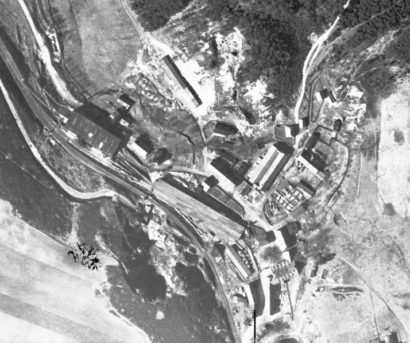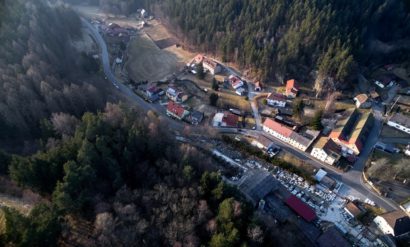Altenhammer Subcamp
December 1944 - April 16, 1945
![]()
Arial shots of Altenhammer taken by the Allies, 1945 (National Archives, Washington D.C.). The barracks of the subcamp can be seen in the middle and upper section.
![]()
Former commando "Ambos" (bottom right) and "Scientific Department" (middle top), aerial view 2018 (Flossenbürg Concentration Camp Memorial / Photo: Rainer Viertlböck)
-
Prisoners
250 Polish prisoners, amongst them ca. 100 Jews, 150 Russian prisoners, 100 Czechs, 50 Germans, 40 each of French and Italian nationality, as well as persons from a further eight nations. In March 1945, 618 prisoners were working for Messerschmitt, another 22 for the work detail "Scientific Department."
-
Forced labor and quarters
Production of airplane parts (Me 109) for Messerschmitt in the work details “Stich” and “Ambos”, from February 1945 in two shifts. Jewish chemists worked in the “Scientific Department” (Wissenschaftlichen Abteilung) on developing a gas protective filter for the navy.
-
The prisoners were quartered in the factory workshops. In February 1945, a typhus epidemic broke out, which was considerably worsened by the catastrophic hygiene conditions.
-
Guards
Detail leader Ewald Reinhold Heerde and 36 guards. Heerde and the production manager, a major in the air force, abused the prisoners, as did the camp elder Wissmann.
-
Death toll
At least 45 prisoners died in Altenhammer, some witnesses speak of up to 200 victims. Many of the ill were transferred back to the nearby main camp and died there.
-
Disbanding of the camp / end of the war
On April 16, the prisoners were placed in the quarantine blocks of the main camp. The German prisoners were liberated in Flossenbürg, while the others were sent on death marches in the direction of Dachau.
-
Commemoration
None. The former production buildings have been dismantled.

